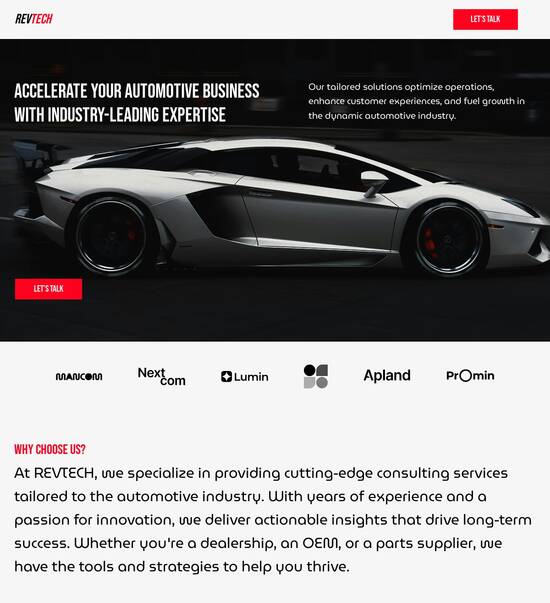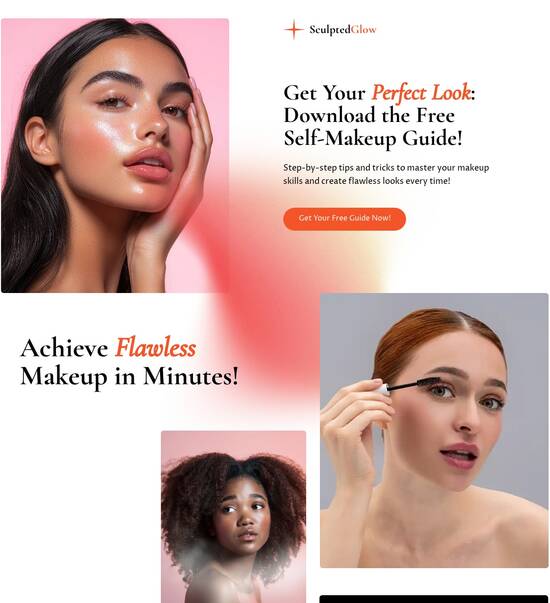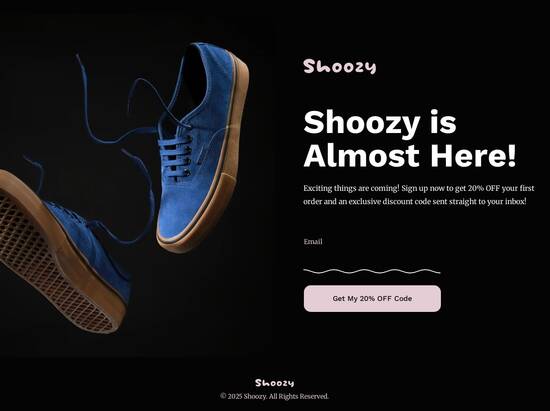
HTML page templates with downloadable resources
Explore Similar TemplatesAbout template
Manage your templates with downloadable resources and improve your conversion rates. Easily facilitate trust and transparency with your customers right now.
Recommended templates

Easy to build without coding
With the intuitive drag-and-drop builder, anyone on your team can create high-converting pages without any knowledge of code or design. Make enhancements to your landing page with custom widgets using Javascript, HTML/CSS, or third-party scripts.

Multiple layouts for any industry and goal
Select from 500+ landing page layouts built to boost conversions across industry-specific scenarios. Customize them by adjusting fonts, adding images, and generating on-brand content with the AI assistant. Quickly scale with Instablocks® and Global Blocks that you can save, reuse, and update globally.

Loads fast and looks polished on any device
Every template is responsive, which means they present professionally on any device and load blazingly fast with our Thor Render Engine. You can also power them up with Google AMP technology to deliver an unparalleled mobile experience and drive higher conversions.

Robust analytics & experimentation
Get real-time updates and reporting across all your devices, showing the number of visitors, conversions, cost-per-visitor, and cost-per-lead. Launch AI-powered experiments, run A/B tests, and use heatmaps to analyze user behavior, then optimize your landing page to maximize conversions.







Easy to build without coding
With the intuitive drag-and-drop builder, anyone on your team can create high-converting pages without any knowledge of code or design. Make enhancements to your landing page with custom widgets using Javascript, HTML/CSS, or third-party scripts.
Multiple layouts for any industry and goal
Select from 500+ landing page layouts built to boost conversions across industry-specific scenarios. Customize them by adjusting fonts, adding images, and generating on-brand content with the AI assistant. Quickly scale with Instablocks® and Global Blocks that you can save, reuse, and update globally.
Loads fast and looks polished on any device
Every template is responsive, which means they present professionally on any device and load blazingly fast with our Thor Render Engine.
Robust analytics & experimentation
Get real-time updates and reporting across all your devices, showing the number of visitors, conversions, cost-per-visitor, and cost-per-lead. Launch AI-powered experiments, run A/B tests, and use heatmaps to analyze user behavior, then optimize your landing page to maximize conversions.
All the features you need to build resource page template
Explore more featuresLearn how to build resources page example
Frequently asked questions about resource page example
Leading the way in building high-performing landing pages





Website resource page examples: Your ultimate how-to guide
Instapage stands out as a leading platform for marketers aiming to enhance their digital campaigns through optimized landing pages. This guide will empower you to utilize Instapage effectively, ensuring your campaigns meet their maximum potential. Let's break down how to accelerate your landing page development process while achieving high ROI and user engagement.
Understanding the power of Instapage
Instapage serves as an all-in-one solution that simplifies the complexities of landing page creation and conversion rate optimization (CRO). From its extensive library of over 100 customizable templates to built-in optimization tools, Instapage is designed to facilitate seamless campaign execution, regardless of your team's size or budget. Marketers across various sectors, including business services and financial services, can benefit significantly from its unique features.
- Pre-built templates and elements: Choose from a diverse range of templates that boost conversion and utilize lead generation elements to enhance your pages.
- Easy-to-use interface: Build landing pages effortlessly without requiring any coding expertise, utilizing its intuitive drag-and-drop functionality.
- Advanced optimization features: Conduct A/B testing and analyze heatmaps to refine your strategies based on real user interactions.
Step 1: Utilizing templates and lead generation tools
Begin by exploring the abundant templates available on Instapage. Each template is designed for high conversion rates and can be quickly modified to suit your specific branding needs. Incorporate lead generation elements like forms and call-to-action buttons that resonate with your target audience.
- Select a template that aligns with your campaign goal — choose one designed for conversions if promoting a product.
- Customize images and text to reflect your unique brand voice, ensuring all messaging is consistent.
- Integrate lead generation tools such as pop-ups and forms prominently on the page to capture visitor information.
Step 2: Customize and personalize your landing pages
Instapage excels in personalization, enabling you to create dynamic content tailored to various audience segments. Use features like dynamic text replacement and AdMaps to ensure your messaging resonates with specific groups.
- Utilize dynamic text replacement to display unique messages for visitors coming from different campaigns or ad sources.
- Align specific ads with the corresponding landing page to create a seamless experience for users.
- Monitor engagement metrics at the audience level to fine-tune your strategies further.
Step 3: Optimize for performance with built-in tools
Once your landing page is live, it's crucial to analyze its performance continually. Leverage Instapage's built-in analytics dashboard and heatmaps to monitor user behavior and make data-driven decisions.
- Conduct regular A/B testing on various elements like headlines and images to identify what works best.
- Use heatmaps to visualize user interaction, allowing you to identify areas for improvement.
- Review analytics regularly to track conversions, bounce rates, and engagement metrics to inform future campaigns.
By following these steps meticulously, marketers can significantly enhance their landing page performance, leading to better campaign outcomes and increased ROI.
Ready to take your landing pages to new heights? Get started with Instapage today and transform your digital marketing efforts with high-converting pages and the tools needed for optimization.
People also ask about resources page design
Exploring the Essence of HTML Page Templates with Downloadable Resources
Understanding HTML page templates
HTML page templates are pre-designed webpage structures that serve as a foundation for creating web content. These templates facilitate consistency in design and structure, allowing developers and designers to focus more on content rather than starting from scratch. The use of HTML templates is crucial in web design and development as they save time and resources while ensuring quality and uniformity across various projects.
The importance of templates extends beyond mere aesthetics; they significantly streamline workflows, especially in fast-paced environments. In industries such as marketing, education, and e-commerce, where rapid deployment of web content is essential, HTML templates can significantly boost productivity by offering ready-to-use designs tailored for specific functions or audiences.
Marketing: Speed up the production of landing pages that convert.
Education: Create consistent course pages for a better user experience.
E-commerce: Design engaging product displays with minimal effort.
The structure of an effective HTML template
An effective HTML template consists of several key components that work together to create a cohesive webpage. The header is the face of your webpage, typically containing the title, logo, and navigation menu. It sets the tone for the visitor’s experience and should be designed to guide them effortlessly through your site. The body is where the main content resides, including text, images, and interactive elements. Structuring this area effectively is vital for ensuring that information is presented clearly and engagingly.
At the end of the page, the footer acts as a repository for essential links, contact information, and copyright details. It's often overlooked but is critical for providing users with navigational aids beyond the primary content. Moreover, integrating CSS is vital for enhancing the visual appeal and functionality of the template, allowing for personalized design elements that align with brand identity.
Header: Includes navigation and branding.
Body: Contains main content and layout.
Footer: Houses contact and policy information.
Differentiating between template types
HTML templates come in various types, each serving unique purposes and audiences. General HTML templates are versatile designs suitable for multiple sectors. They offer advantages such as adaptability and ease of use, making them ideal for various organizations that may not need highly specialized sites. These templates provide an excellent starting point, especially for small businesses or startups with limited budgets.
Meanwhile, e-commerce HTML website templates are specifically configured for online stores. These designs often feature product showcases, shopping carts, and customer reviews, optimizing user experience and sales potential. On the artistic side, portfolio templates are designed to showcase creativity, focusing on visual appeal with layouts that highlight artwork, photography, or other services. Effective portfolio templates ensure that an artist's work takes center stage while maintaining an easy navigation experience.
General HTML templates: Flexible for diverse uses.
E-commerce templates: Focus on sales and usability.
Portfolio templates: Showcase creativity and artistry.
The benefits of downloadable resources
Downloadable resources associated with HTML templates significantly enhance the development process for designers and developers alike. These resources include graphics, multimedia files, and additional coding libraries that can expand a template’s functionality. Downloadable content allows users to incorporate high-quality images, video backgrounds, or other media formats into their designs seamlessly, enhancing the overall user experience and engagement.
Having access to these resources also means users can customize templates to better fit their brand or message. For instance, integrating specific graphics or video content can make a webpage stand out and fulfill unique marketing objectives. This aspect addresses the growing demand for interactive and visually appealing websites that cater to target audiences.
Enhanced functionality through additional coding libraries.
Incorporation of multimedia formats for dynamic interactions.
Customization options for aligning with brand identity.
Diving deeper: Block templates and their applications
Block templates represent a modular approach to web design, allowing users to create pages using reusable sections or 'blocks'. Each block can comprise various content types, from text and images to forms and galleries, streamlining the design process. This methodology fosters efficiency, enabling quick assembly of pages without requiring extensive coding knowledge.
Examples of effective block templates include sections specifically crafted for blog posts, service offerings, and testimonials. Utilizing block templates can help businesses implement a dynamic and cohesive web presence, where each section conveys relevant information while promoting user interaction. Whether crafting an extensive blog or a simple service menu, the ease of block components enhances both speed and creativity in web design.
Blog sections: Easy layout and content management.
Service offerings: Clear presentation of services.
Testimonials: Building trust through user feedback.
Tailoring your HTML page with a template editor
Template editors provide a user-friendly interface for customizing HTML templates. These tools often come equipped with features such as drag-and-drop functionality, making it easy for users to manipulate elements on the page without the need for extensive coding experience. The ability to preview changes in real-time aids in maintaining design integrity while allowing for creative exploration.
When selecting a template editor, look for specific capabilities that can enhance your workflow. Code customization should be straightforward for those who have some development skills, while intuitive navigation tools can assist beginners. Additionally, a collaborative option can be beneficial, allowing teams to work simultaneously, provide feedback, and streamline the editing process.
Drag-and-drop functionality for ease of use.
Code customization options for advanced users.
Real-time preview features for instant feedback.
CSS: The aesthetic empowerment of HTML templates
The integration of CSS with HTML templates enhances visual appeal and functionality. CSS controls the layout, color schemes, and font styles, critical components that bring the design to life. By utilizing CSS frameworks like Bootstrap or Tailwind, developers can employ standardized styles that offer flexibility and speed in building responsive designs.
The impact of CSS goes beyond aesthetics; it also plays a vital role in SEO and user experience. Search engines favor well-structured sites with clear hierarchies and fast loading times, both of which CSS helps to achieve. Moreover, CSS elevates user interaction by providing visual cues and responsive designs that adapt to different devices, ensuring a consistent experience across desktops and mobile platforms.
CSS controls layout, color, and visual hierarchy.
Frameworks like Bootstrap streamline design processes.
Affects SEO and user engagement through optimal design.
Customization strategies for business and portfolio templates
Tailoring templates to align with brand identity is essential for creating a cohesive online presence. This might involve adjusting color palettes, typography, and images to reflect the values and style of a particular brand. In terms of content structuring, businesses should focus on clarity and engagement. Important information should be easily accessible, guiding visitors through the site with logical navigation and intuitive layout.
Furthermore, successful customization balances aesthetic appeal with functional design. For example, a portfolio site should showcase creativity but also provide easy access to contact information and project descriptions. Implementing these strategies not only enhances user engagement but also drives conversion rates, ultimately contributing to business success.
Align colors and styles with brand identity.
Ensure clarity and easy navigation.
Balance aesthetics with functional design.
Innovative showcase: Templates empowering modern web design
Numerous businesses have embraced the power of HTML templates to enhance their online presence, showcasing innovative uses that highlight the flexibility and creativity of these tools. Case studies illustrate how companies have improved user engagement and conversion rates through targeted use of templates. For instance, an education platform might leverage a clean, organized HTML template to guide users easily through course offerings, effectively leading to better enrollment numbers.
Moreover, portfolio websites have seen an upswing in successful designs that effectively utilize HTML templates. By showcasing work prominently while maintaining functionality for contact and inquiries, creatives can maximize their impact. Current trends in web design, such as minimalism and mobile-first design, continually influence how templates are developed and utilized, pushing the envelope of creativity within the web design space.
Increased engagement through targeted template use.
Educational platforms using clean designs for guidance.
Portfolios maximizing exposure while maintaining usability.
Best practices for downloading and implementing HTML templates
Selecting the right template is crucial for meeting specific project goals. Conduct thorough research to identify templates that best fit your needs in terms of functionality, design, and responsiveness. Look for templates that offer user reviews or ratings as indicators of reliability and quality. Once you’ve made a selection, ensure to download it from reputable sources to avoid issues with malware or compatibility.
After downloading, editing and personalizing the template to fit your brand should be straightforward. Take advantage of template editors or simple code adjustments to make modifications. Additionally, ensure that the template is compatible with your existing systems and can be adapted for potential future expansions, which is vital for long-term usability.
Conduct thorough research before selection.
Download from reputable sources.
Ensure compatibility with existing systems.
Future trends in HTML templates and web design
Looking ahead, the future of HTML templates and web design appears promising and technologically driven. Expect templates to evolve with features that cater to personalized user experiences, driven by data analytics and user preferences. The integration of AI and automation in template creation will transform how designers develop and customize templates, making it faster and more efficient.
Furthermore, emphasizing customization and personalization will become paramount. Users will increasingly seek templates that not only meet functional needs but also resonate with their individual brand identities and user demographics. This shift calls for innovation in template design, where uniqueness is merged with practicality, enhancing the value of HTML templates in various domains.
Predictions for AI-driven template customization.
Increasing focus on personalization in design.
Emerging trends blending uniqueness with functionality.
Engaging readers through practical insights
In summarizing the contributions and functionalities of HTML page templates, it is clear that they serve as a fundamental tool in modern web design. With their inherent flexibility, downloadable resources, and integrated features, these templates can significantly enhance not just the design process, but also the overall effectiveness of websites across various industries.
Encouraging readers to explore and experiment with these resources can lead to innovative designs that meet individual needs and objectives. Whether for business pursuits or personal projects, templates offer transformative potential in achieving desired outcomes, thus strengthening brand visibility and user loyalty.
Ready to skyrocket conversions?
Supercharge your ad campaigns with high-performing landing pages
Get started














